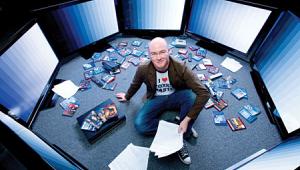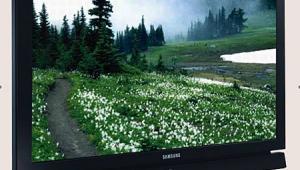Exactinside's VMware 2V0-21.23 questions and answers are meticulously crafted to provide comprehensive preparation for the VMware Certified Professional - Data Center Virtualization 2021 (VCP-DCV 2021) exam. With a focus on accuracy and relevance, these resources cover all key topics and objectives outlined in the exam blueprint.
The questions are designed to simulate the format and difficulty level of the actual exam, offering candidates an opportunity to familiarize themselves with the types of questions they may encounter on test day. They encompass a variety of question types, including multiple choice, scenario-based, and interactive items, ensuring thorough coverage of the exam content.
The 2008 HDTV Technology Face Off Mitsubishi WD-57833 DLP RPTV
It's good to be in the middle.
With the WD-57833, we reach the middle of the pack. Unlike the JVC and Sony that surround it, the Mitsubishi showed no major flaws to hold it back. Instead, it goes about its business being a solid, if not a stand-out, performer.

Sunglasses
At 109.4 ft-L, Mitsubishi's WD-57833 was the brightest display in the Face Off. On the other end, the black level was 0.027 ft-L. This was mid pack for the RPTVs and fairly high in number for the Face Off, but it seems lower when you're watching it. Tom picked this set as a solid number three, on the basis of its black level and contrast ratio. The WD-57833's ANSI contrast ratio of 357:1 surely has something to do with that, as it's by far the highest of the RPTVs here and well above average for RPTVs in general. The full-on/full-off contrast ratio of 4,052:1 certainly didn't hurt the overall look, and it's among the highest in the Face Off. While there are no settings to adjust it, this is presumably due to an auto iris, and, as such, it's somewhat higher than reality. That said, this auto iris works behind the scenes, and in the dark scenes, it certainly helps win over those that are allergic to high black levels. Take, for example, the Samsung. It uses a similar (if not the same) DLP chip, but it does so without an iris. With similar overall light outputs, the Mitsubishi has a black level that is a third of the Samsung's. This, as well as the relatively high ANSI contrast ratio, let the WD-57833 avoid the poor black-level complaints the Samsung received.
 Processing was better than average, passing all of the deinterlacing tests. However, detail wasn't great. There were several comments about a softness compared with some of the other displays here. It wasn't as extreme as the Sony, but it was still softer than most. All of the panelists mentioned some noise as well.
Processing was better than average, passing all of the deinterlacing tests. However, detail wasn't great. There were several comments about a softness compared with some of the other displays here. It wasn't as extreme as the Sony, but it was still softer than most. All of the panelists mentioned some noise as well.
Color, too, presented an issue. While the color points weren't as oversaturated as those of some of the other displays, there were still comments that the colors seemed to be a little off. Maureen Jenson, who also picked this set third overall, felt the greens looked a little "cartoony," while Tom felt they were too "electric." DBJ, who really didn't like this set, claimed that Liam Neeson in the Batman Begins clip was "Oompa-Loompan." Seeing as Qui-Gon stands 6 feet, 4 inches tall, I'm guessing he meant in regards to color.
This was one of the few sets to get acclaim for its aesthetics. In a sea of black boxes, there was something about the WD-57833's thin, glossy black bezel that drew several positive comments.
Mid
The WD-57833 is the same price as the Samsung, but it's 4 inches smaller and performs far better. The podium finishers may have performed better; but, with one exception, they were $1,000 more expensive. That one exception was $200 cheaper and a little larger, which partially explains its number-three ranking. So, despite some knocks, most of the panelists agreed that there wasn't a lot to dislike about the WD-57833, but there just wasn't much to set it apart.
Highlights
• Solid performer
• Bright
At A Glance: Mitsubishi WD-57833 DLP RPTV

Features
Type: DLP
Screen Size (diagonal, inches): 57
Native Resolution: 1,920 by 1,080
Lamp Life: N/A
Dimensions (H x W x D, inches): 35 x 51.3 x 13.9 Weight (pounds): 62.4
Price: $2,500
Connections
Inputs:
Video: HDMI (4), component video (3), S-video (2-shared), composite video (2-shared)
Audio: Analog stereo (5)
Outputs:
Video: Composite (1)
Audio: Coax (1), analog stereo (2)
Additional: FireWire (2), RS-232 (1), 3D sync out, USB
HT Labs Measures: Mitsubishi WD-57833 DLP RPTV


Full-On/Full-Off Contrast Ratio—4,052:1; ANSI Contrast Ratio—357:1
Measured Resolution with the Leader LT-446:
480: 480 (per picture height)
720p: 720 (pph)
1080i: 1080 (pph)
DC Restoration (poor, average, good, excellent): Excellent
Color Decoder (poor, average, good, excellent): Average – Adjustable to Excellent
Measured Color Points:
Red Color Point: x=0.643, y=0.340
Green Color Point: x=0.315, y=0.643
Blue Color Point: x=0.147, y=0.073
The top chart shows the WD-57833's gray scale relative to its color temperature at various levels of intensity, or brightness (20 IRE is dark gray; 100 IRE is bright white). The gray scale as set by the factory, in the Low color-temperature mode and the Natural picture mode, measures very warm. After making adjustments using the Photo Research PR-650, the gray scale measures closer to D6500, the accurate color temperature, but it's still rather warm on the low end.
The bottom chart shows the gray scale (or color temperature) relative to the color points of the display's red, green, and blue color-filter-wheel segments. These are somewhat off those specified by SMPTE. Red is very slightly reddish-orange, and green is somewhat oversaturated and somewhat yellowish-green. Blue is slightly greenish-blue.
After calibration, and using a full-field 100-IRE white (109.4 foot-lamberts) and a full-field 0-IRE black (0.027ft-L), the contrast ratio was 4,052:1. Using a 16-box checkerboard pattern (ANSI contrast), the contrast ratio was 357:1. The best contrast ratio and brightest image were achieved in the with the Lamp Mode set to Bright. The best black level was achieved with the Lamp Mode set to Standard. In this mode, the WD-57833 produced 94.82 ft-L and 0.024 ft-L for a contrast ratio of 3,951:1.—GM
Ratings: Mitsubishi WD-57833 DLP RPTV
Build Quality: 88 Average
Value: 90 Good
Features: 90 Good
Performance: 88 Average
Ergonomics: 87 Average
Overall Rating: 89 Average
General Information
WD-57833 DLP RPTV, $3,300
Mitsubishi
(800) 332-2119
www.mitsubishi-tv.com
- Log in or register to post comments




























































